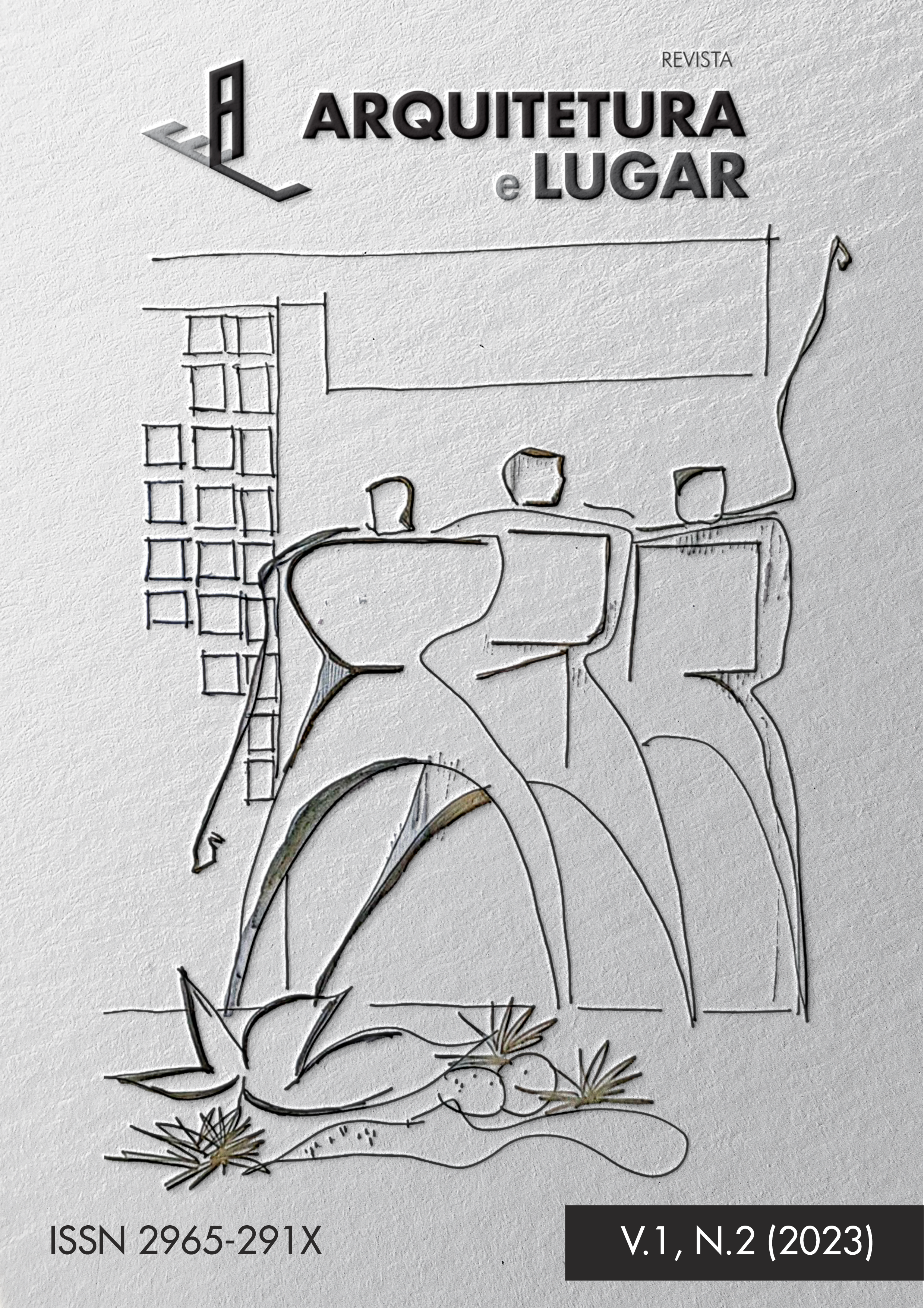LOS MATERIALES CONSTRUCTIVOS DEL EDIFICIO EN RECIFE Y OLINDA
Palabras clave:
historia de las construcciones, materiales constructivos, Olinda y Recife, rocas calizas y areniscas, morteros de cal y puzolanasResumen
El presente estudio tiene por finalidad contextualizar como se estructuraron las edificaciones históricas de las ciudades de Recife y Olinda, Brasil, y así, permitir comprender cuáles y de qué forma los materiales constructivos fueron utilizados en esos edificios. En la óptica del contexto histórico se puede intervenir en el patrimonio edificado comprendiendo sus materiales y técnicas constructivas sin agredirlos y preservándolos en autenticidad, donde la compatibilidad de los materiales es la prerrogativa. El trabajo aborda una breve historia de los materiales por la humanidad. A continuación, trata el contexto histórico de los materiales de construcción de Olinda y Recife hasta fines del siglo XVIII.
Descargas
Citas
ALMEIDA, Frederico Faria Neves. Manual de Conservação de cantarias: manual. Brasília: IPHAN, 2005.
ALVAREZ, J.. Alvenaria e argamassas anteriores ao Império Romano. In: 2° Congresso Nacional de Argamassas de Construção. Lisboa: 2007.
ALVAREZ, J; SEQUEIRA, C.; COSTA, M.. Ensinamentos a retirar do Passado Histórico das Argamassas. In: 1° Congresso Nacional de Argamassas de Construção. Lisboa: 2005.
ARAÚJO, Roberto A. Dantas de. O Ofício da Construção na Cidade Colonial: organização, materiais e técnicas (o caso pernambucano). vol. I e II. São Paulo: Tese de Doutorado em Arquitetura – Universidade de São Paulo, 2002.
BENEVOLO, Leonardo. Introdução à Arquitetura. São Paulo: Editora MestreJou, 1972.
CAMPOS, Maria Aparecida Nogueira; REIS, Alessandra Savazzini dos; TRISTÃO, Fernando Avancini; ROCHA-GOMES, Leila Verônica da. A utilização da cal conchifera em monumentos históricos do Espírito Santo. In: 2° Congresso Português de Argamassas de Construção. Lisboa: 2007.
CARASEK, H. Argamassas. In: IBRACON Materiais de Construção Civil e Princípios de Ciência e Engenharia de Materiais. 2° Atualizada e ampliada. ed. São Paulo: IBRACON, v. 2, 2010. Cap. 28, p. 893.
CARVALHO, Ayrton. Algumas notas sobre o uso da pedra na arquitetura religiosa no Nordeste. In: Revista do Serviço do Patrimônio Histórico e Artístico Nacional. Rio de Janeiro: Ministério da Saúde e Educação, 1942. p. 277 – 294.
COSTA, Francisco A. Pereira. Anais Pernambucanos: 1635 -1665. Recife: Arquivo Público Estadual, 1952. Vol.III. p. 417 - 421.
______. ______:1701 -1739. Recife: Arquivo Público Estadual, 1953. vol. V. p.128 – 132 e p. 437 – 445.
______. ______: 1818-1823. Recife: Arquivo Público Estadual, 1962. vol. VIII. p. 499.
______. ______: 1824 - 1833. Recife: Arquivo Público Estadual, 1965. vol. IX. p. 351 – 354.
______. ______: 1834 -1850. Recife: Arquivo Público Estadual, 1985. vol. X. p. 200 - 205.
FAZIO, Michael; MOFFETT, Marian; WODEHOUSE, Lawrence. A História da Arquitetura Mundial. 3 ed. Porto Alegre: Editora Bookman, 2011.
FREYRE. Gilberto. Um Engenheiro Francês no Brasil. Rio de Janeiro: José Olympio, 1960.
GUERRA, Flávio. Velhas igrejas e subúrbios históricos. Recife: Itinerário, 1978.
HERKENHOFF, Paulo (Org.). O Brasil e os Holandeses: 1630-1654. Rio de Janeiro: GMT Editores, 1999.
MAGALHÃES, A. Cristian. Patologias de rebocos antigos. 3° ed. LNEC, Cadernos de Edifícios, n°2, 2011, p. 69 – 85.
MASSAZZA, F. Pozzolana and Pozzolanic Cements. In: HEWLETT, P. C. LEA'S Chemistry of Cement and Concrete. 4. ed. Toquío: Elsevier, 1988. Cap. 10, p. 487-501.
MELLO, José Antônio Gonçalves de. Tempo dos Flamengos. 2° Edição. Volume VX. Coleção Pernambucana. Recife: Governo do Estado de Pernambuco – Secretária de Educação e Cultura, 1978, p. 77.
MELO, Ulysses Pernambucano de. O Cabo de Santo Agostinho e a Baia de Suape. In: Revista do Inst. Arq. Hist. e Geo. Pernambucano. Recife: 1981. Vol. 53.
MENEZES, José Luiz Mota. Algumas Notas sobre a Arquitetura Brasileira. In: Revista Arquivos. N° 1. PMR/SEC. Recife: 1976. p. 129 - 164.
MENEZES, José Luiz Mota. O Recife das Origens até a chegada dos Holandeses (1535-1630). MOREIRA, Fernando Diniz (Org.). In: Recife Cinco séculos e cidade e arquitetura. Recife; CEPE, 2022.
MINISTÉRIO DA EDUCAÇÃO E CULTURA; IPHAN; UNIVERSIDADE DE SÃO PAULO; FACULDADE DE ARQUITETURA. Arquitetura Civil I. São Paulo: FAU/USP, MEC-IPHAN, 1981.
MINC.. Imagens do Brasil Holandês 1630 – 1654. Rio de Janeiro: Raízes Artes Gráficas, 1987.
POLLIO, Marcus Vitruvius. Tratado de Arquitetura: Vitrúvio. Tradução, introdução e notas de M. Justino Maciel. São Paulo: Martins, 2007.
PORTOCARRERO, José Afonso Botuca. Tecnologia indígena em Mato Grosso: Habitação. 2 edição. Cuiabá: Entrelinhas, 2018.
SANTIAGO, Cybèle Celestino. Argamassas tradicionais de cal. Salvador: EDUFBA, 2007.
SEGURADO, João Emílio dos Santos. Biblioteca de Instrução Profissional: Materiais de Construção. 5° Ed. atualizada. Lisboa: Livraria Bertrand. s/d.
SMITH, Robert C.. Igrejas, Casas e Móveis: Aspectos de Arte Colonial Brasileira. Trad. Benício Whatley Dias. Recife: UFPE/IPHAN, 1979. 266 p.
SOUZA, Juliana Santa Cruz. As Inovações Tecnológicas de Construção do Século XIX: Sincretismo Construtivo da Basílica de Nossa Senhora da Penha. Recife:Trabalho de conclusão do curso de Arquitetura e Urbanismo, UFPE, 2010.
SOUZA, Juliana Santa Cruz. Estudo de argamassas à base de cal e metacaulim para intervenção em revestimento das edificações históricas. Dissertação de Mestrado em Engenharia Civil – Universidade Federal de Pernambuco, 2013.
SOUZA, Juliana Santa Cruz. A influência do metacaulim na cristalização das hidrogranadas nas pastas de cal. Tese de Doutorado em Engenharia Civil – Universidade Federal de Pernambuco, 2019.
SOUZA, Juliana Santa Cruz; OLIVEIRA, Felisbela M. daCosta; CARNEIRO, A. M. P.. Edificações históricas e a incompatibilidade com argamassas ricas em cimento Portland In: Congresso Brasileiro de Patologias das Construções - CBPAT, 2018, Campo Grande.Anais do Congresso Brasileiro de Patologias dasConstruções - CBPAT, 2018.
VASCONCELLOS, Sylvio de. Arquitetura no Brasil: Sistemas construtivos. 4° Edição revista. Belo Horizonte: editora da UFMG, 1971.
Descargas
Publicado
Versiones
- 2023-05-19 (2)
- 2023-05-01 (1)
Cómo citar
Número
Sección
Licencia
Derechos de autor 2023 Revista Arquitectura y Lugar

Esta obra está bajo una licencia internacional Creative Commons Atribución-NoComercial-SinDerivadas 4.0.
Los autores que publican en esta revista aceptan los siguientes términos:
1. Los autores mantienen los derechos de autor y otorgan a la revista el derecho de primera publicación, estando la obra licenciada simultáneamente bajo la Licencia Creative Commons Atribución-No Comercial-SinDerivadas 4.0, que permite compartir la obra con reconocimiento de autoría y publicación inicial en esta revista;
2. Los autores están autorizados a celebrar contratos adicionales por separado, para la distribución no exclusiva de la versión del trabajo publicado en esta revista (por ejemplo, publicación en un repositorio institucional o como capítulo de libro), con reconocimiento de autoría y publicación inicial en esta revista;
3. Se permite y se anima a los autores a publicar y distribuir su trabajo en línea (por ejemplo, en repositorios institucionales o en su página personal) una vez finalizado el proceso editorial, ya que esto puede generar cambios productivos, así como aumentar el impacto y la citación del trabajo. trabajo publicado (ver El efecto del acceso abierto);
4. No se recomienda publicar y distribuir el artículo antes de su publicación, ya que esto puede interferir con su revisión ciega por pares.




